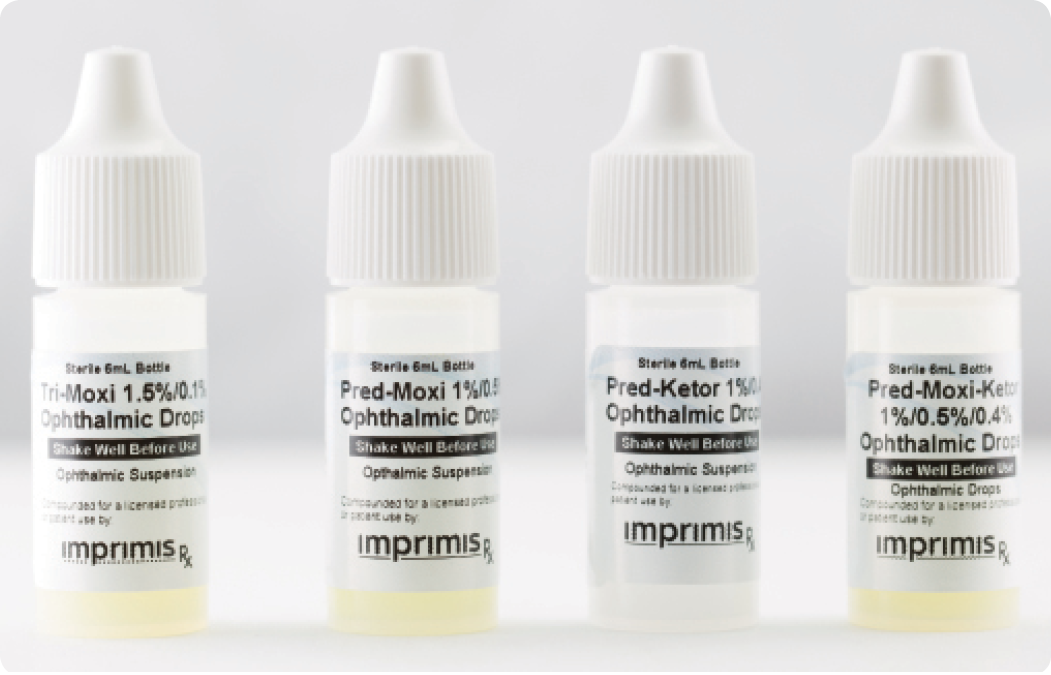
The use of compounded medication is a convenient and cost-effective practice that has improved the LASIK surgical experience for both my office staff and our patients. Traditional medication regimens after LASIK are intended to reduce the likelihood of infection and inflammatory response, and they generally include two or more self-administered topical eye drops instilled four times daily for up to 4 weeks. The instillation of multiple drops can confuse patients, create problems with compliance and dosing, and expose the eye to the potential for self-induced trauma.
EVALUATION
After my successful adoption of the compounded medications Tri-Moxi (triamcinolone acetonide and moxifloxacin HCl) and Tri-Moxi-Vanc (triamcinolone acetonide and moxifloxacin HCl with vancomycin; both formulations from Imprimis Pharmaceuticals) for intraocular administration during cataract and other surgical procedures, I looked to Imprimis to produce a compounded formulation of the topical postsurgical medications I prescribe to LASIK patients. These are typically moxifloxacin, a fourth-generation synthetic fluoroquinolone antibacterial agent, and a steroid such as prednisilone acetate. Combining these two classes of medications reduces the number of patient-administered drops by 50%. The cost of the medications for the patient also decreases.
At a Glance
• Compounded formulations can enhance compliance and reduce the potential for self-induced trauma.
• The LessDrops approach after LASIK offers advantages for staff, in that fewer patients call the office to seek clarification of their postoperative instructions.
I led the evaluation of two of Imprimis’ proprietary LessDrops compounded formulations, Tri-Moxi and Pred-Moxi (prednisolone acetate and moxifloxacin HCl) combination eye drops. We compared the results to our traditional postsurgical regimen to assess efficacy and drug quality. Sixty LASIK patients randomly received either one bottle of Pred-Moxi or Tri-Moxi topical drops with instructions to administer the drops four times a day for 1 to 2 weeks (as required for individual healing times). No additional medications were prescribed. One week and again 1 month after surgery, I measured IOP, visual acuity, programmed refraction in both eyes, and manifest refraction in both eyes, and I compared these findings with preoperative measurements. I also measured visual acuity 1 day after surgery. My findings indicated that the results were indistinguishable from each other; patients experienced no safety issues or adverse events, and the eye drops were well tolerated. At week 1, early in the healing response and during the time the medications were being used, 47% of the patients had a visual acuity of 20/15, and 82% saw 20/20 or better, comparable to what our practice has observed with traditional post-LASIK eye drop regimens.
ADVANTAGES OF USING LessDrops
The implementation of the LessDrops approach into our postsurgical protocol offers my staff and patients several advantages. First and foremost, it reduces the risk of patient-inflicted trauma by decreasing possible contact between the dropper and LASIK flap by 50%. The strategy also reduces patients’ confusion over drop administration through simple dosing instructions: one drop four times daily. Patients no longer call our office to clarify the order in which the drops should be administered or how long to wait between instilling drops.
Use of LessDrops increases patients’ compliance and therefore the efficacy of the medication by reducing the washout that occurs when multiple topical medications are dosed too close together. Otherwise, because patients must wait at least 5 minutes between dosing, they may become distracted and forget to administer the second medication. The LessDrops approach also significantly reduces the number of pharmacy-related calls to the office. Some pharmacists are under pressure to substitute generic medications when insurance is involved, and patients are often taken aback by the high cost of the name-brand medications and will call to request a generic version. This may delay prescription dispensing as we research potential complications caused by the generic substitutions. We risk exposing patients to preservatives and potential irritants often used in generic medications or upsetting patients by denying them access to lower-cost generic medications.

The LessDrops approach also offers the convenience of ordering the medications from a single pharmacy source with delivery directly to our LASIK center on the day of surgery. We complete a single order form indicating patients’ individual information, and the medication is available in our office when needed. Using a combination product also reduces the medication’s cost. In a highly competitive LASIK market, any convenience recognized by the patient can provide a marketing advantage to a practice.
CONCLUSION
I appreciate that this high-quality medication is compounded in a sterile, accredited facility. Imprimis’ proprietary ophthalmic formulations employ patent-pending technology producing a solubilized, predictable, well-distributed, micronized particle suspension of the active pharmaceutical ingredients. The strategy also allows me to customize formulations and take advantage of newer medications and strategies to provide novel solutions for my patients. Compounded medications give me the potential flexibility to add agents such as nonsteroidal anti-inflammatory drugs for pain relief or cyclosporine for dry eye, thus overcoming an unmet need in the market. n
Noel Alpins, FRANZCO, FRCOphth, FACS
• private practice at the Cleveland Eye Clinic, Cleveland, Ohio
• assistant clinical professor of ophthalmology, University Hospitals/Case Western University, Cleveland, Ohio
• (440) 526-1974; drwiley@clevelandeyeclinic.com; Twitter @wiley2020
• financial disclosure: consultant to and has received study-related income from Imprimis


